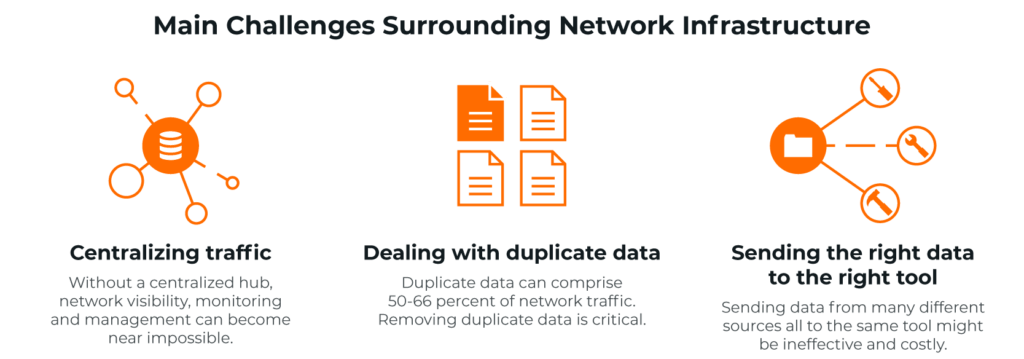What Is Network Infrastructure?
Your network is at the heart of your business. But for it to function correctly, it needs the right support — in the form of effective network infrastructure. What is network infrastructure exactly? And how can you ensure that you’re getting the most out of it?
In this digital age, an organization’s agility and productivity depend on more than just hardworking employees and excellent equipment. Running a smooth operation also requires a robust, clean and secure network infrastructure. Without the right network infrastructure in place, you may suffer from poor user experience and security issues that can impact employee productivity, cost you money and damage your brand.
Network infrastructure refers to all of the resources of a network that make network or internet connectivity, business operations, and communications possible.
As such, it’s critical for business executives to understand the importance of network infrastructure and be aware of the challenges and opportunities it presents. With this knowledge and the right tools in place, you are taking the first steps to ensuring optimum productivity and helping your organization maintain peak levels of performance.
What Is Network Infrastructure?
Network infrastructure refers to all of the resources of a network that make network or internet connectivity, management, business operations and communication possible. Network infrastructure comprises hardware and software, systems and devices, and it enables computing and communication between users, services, applications and processes. Anything involved in the network, from servers to wireless routers, comes together to make up a system’s network infrastructure. Network infrastructure allows for effective communication and service between users, applications, services, devices and so forth.
What Is the Difference Between Network Infrastructure and IT Infrastructure?
Network infrastructure and IT infrastructure are similar. However, while they may at times refer to the same thing, there can also be subtle differences between the two. Often, IT infrastructure is seen as the larger, more encompassing term. IT infrastructure (or information technology infrastructure) defines a collection of information technology elements foundational to an IT service. Often, information technology infrastructure refers to physical components like hardware, but it can also encompass some network or software components.
Network infrastructure and network infrastructure services may be seen as a smaller category within the larger IT infrastructure definition. A sound network infrastructure supports the success of the broad IT infrastructure. A company needs both a solid IT infrastructure and network infrastructure to have cohesive solutions and sustained success.
Why Network Infrastructure Is the Most Important Component of IT Infrastructure
It’s important to have a reliable IT infrastructure and also qualified people, but neither of those are sufficient without a well-built network infrastructure. A network infrastructure enables connection and communication, each of which are critical to the success of a business. Simply put, without a sound network infrastructure, IT components including hardware and software aren’t much use. Making sure your network infrastructure is robust, secure and clean is critical to organizational excellence.
What Are the Main Challenges Surrounding Network Infrastructure?
There are a number of challenges in regard to running a network infrastructure model. Some of the top three network infrastructure challenges are:
- Centralizing traffic
- Dealing with duplicate data
- Sending the right data to the right tool
1. Centralizing Traffic
Within an organization, there are often multiple different subnets and locations or sites. Without a centralized hub, network visibility, monitoring and management can become near impossible. Many companies use network infrastructure solutions to centralize traffic to better understand and monitor the data traversing their networks. This enhances their security posture and helps network operations teams address performance issues.
2. Dealing with Duplicate Data
In some cases, duplicate data can comprise 50 – 66 percent of network traffic. Removing duplicate data is critical, particularly when it comes to the effectiveness of network security solutions. If the security solutions get too much duplicate data, they may be slowed down and less effective in detecting threats.
3. Sending the Right Data to the Right Tool
Many organizations use a number of different cyber security tools and providers. Many security providers often charge based on how much data they need to process. As such, sending the right type of data to the right tool is a critical aspect of infrastructure networking. Sending data from many different sources all to the same tool might be ineffective and costly, particularly if one tool is best suited to one type of data and another tool to another type.
How Does Gigamon Help?
Keeping a clean and efficient network infrastructure is no small feat. That’s why it’s helpful to have a company with deep networking and security expertise on your side. Network infrastructures simply aren’t as cut and dried as they used to be; they are now often a mix of on-premises and cloud, including network infrastructure services. And even within on-premises networking, there tends to be a mishmash of different types of networks and vendors.
Inorganic growth and mergers and acquisitions can further muddle the network infrastructure. The result is that companies can end up with five separate tools that all monitor and manage one large hybrid network. For companies that want to keep their network safe and operating at peak performance, this is not ideal. Establishing one centralized hub for network visibility is critical and so is the ability to direct the right traffic to the right tools. That’s where Gigamon comes in.
The Importance of Network Visibility
Maintaining full visibility across your whole network infrastructure is key for both performance monitoring and threat detection. And dealing with network blind spots is a major pain point for many organizations. Gaining broad network visibility enables you to uncover those blind spots, so threats from all sources can be identified and remediated more quickly. Gigamon has the tools and capabilities you need to establish a robust network security infrastructure.
Streamlining the Data Going to Your Tools
Gigamon can help you greatly improve the efficiency of your network and security tools by removing duplicate data usually sent to these tools. Gigamon also enables intelligent traffic filtering so only the appropriate traffic is sent to the right tools. For example, email traffic is sent to email security tools, but video traffic is not.
With Gigamon, you can free up expensive storage and processing resources used to handle redundant or irrelevant data. Therefore, you can delay future investments and/or leverage existing tools to cover more of your network.
The Takeaway
Network infrastructure is the foundation upon which a successful organization builds. That said, protecting and cultivating a healthy network infrastructure can be a tall task. It’s also one that might be often overlooked. Cleaning up your network and making sure it’s strong and secure is an important endeavor. Get the right tools and solutions on your side and you’ll build a strong base that will keep your network running smoothly for years to come.
Further Reading
Featured Webinars
Hear from our experts on the latest trends and best practices to optimize your network visibility and analysis.

CONTINUE THE DISCUSSION
People are talking about this in the Gigamon Community’s Networking group.
Share your thoughts today








 Dan Daniels
Dan Daniels




